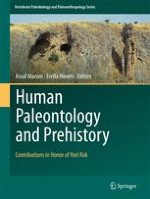2017 | OriginalPaper | Chapter
19. Brother or Other: The Place of Neanderthals in Human Evolution
Authors : Rachel Caspari, Karen R. Rosenberg, Milford H. Wolpoff
Published in: Human Paleontology and Prehistory
Publisher: Springer International Publishing
Activate our intelligent search to find suitable subject content or patents.
Select sections of text to find matching patents with Artificial Intelligence. powered by
Select sections of text to find additional relevant content using AI-assisted search. powered by
